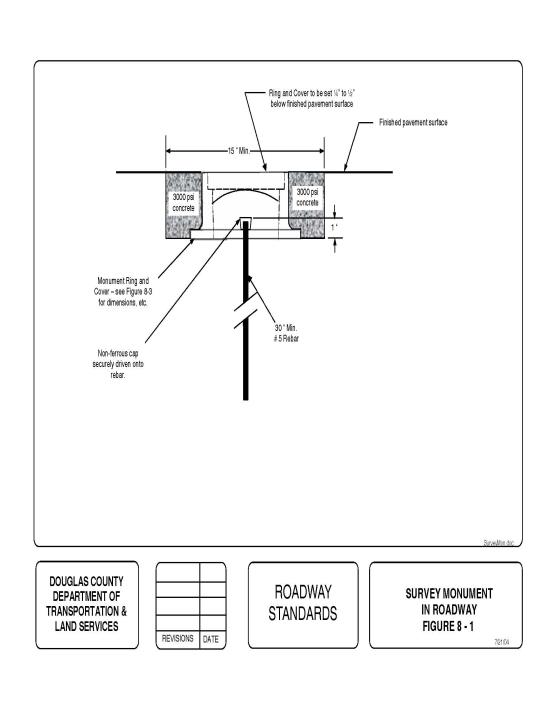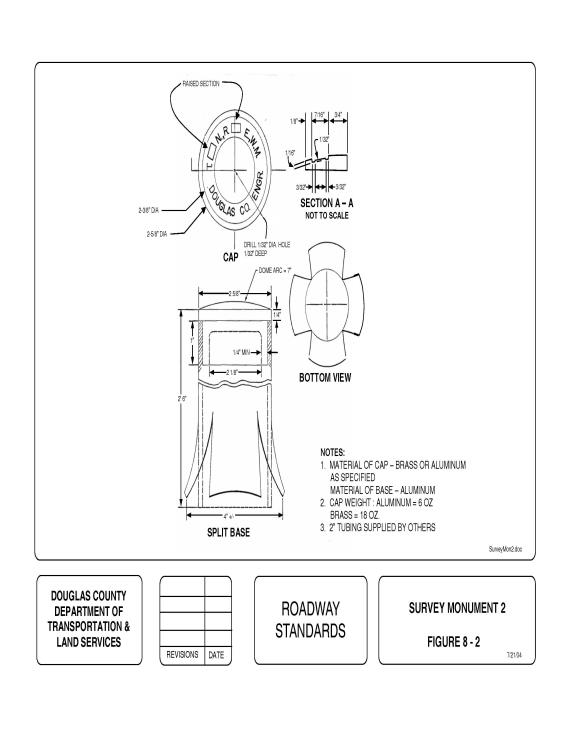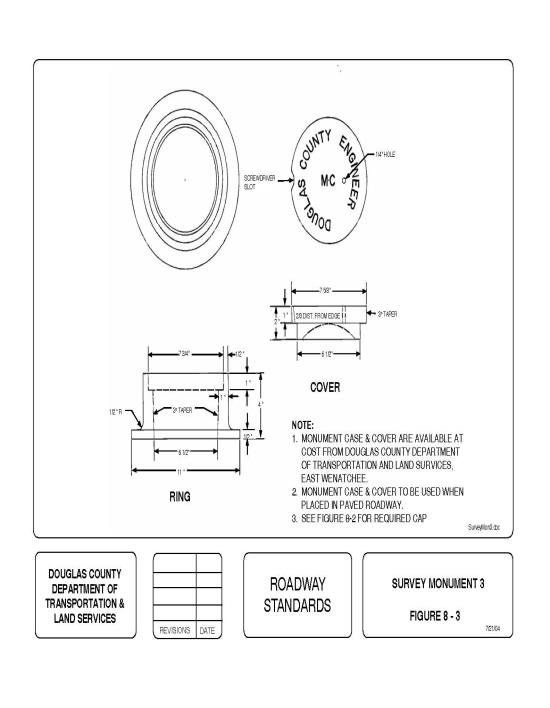Chapter 12.57
ROADSIDE FEATURES
Sections:
12.57.100 Roadway illumination.
12.57.120 Roadway permanent signing and pavement markings.
12.57.010 Retaining walls.
A. General Design Requirements. Retaining walls on public roads shall be designed and constructed to meet the minimum requirements of the AASHTO Bridge Specifications. Retaining walls with a height of four feet or greater and all retaining walls with a surcharge shall be designed by an engineer, and shall be submitted by the applicant for approval by the county engineer.
B. Segmental or Modular Walls (Mortarless Concrete Block Walls) and Rockery Walls. Mortarless concrete block walls shall be designed and constructed in accordance with the manufacturer’s design and construction recommendations. For all such walls the manufacturer’s design details and recommendations shall be furnished to the county engineer for approval. Rockery walls shall be designed by an engineer. (Ord. TLS 11-02-02B Exh. B (part): Ord. TLS 09-11-49E (Exh. B) (part): Ord. TLS 04-02-30B Exh. A (part))
12.57.020 Side slopes.
A. Side slopes shall generally be constructed no steeper than two to one on both fill slopes and cut slopes. Steeper slopes may be approved by the county engineer upon showing that steeper slopes, based on soils analysis, will be stable.
B. Side slopes shall be stabilized by grass sod, hydroseeding, or by planting or surfacing materials acceptable to the county engineer. Hydroseeding mix shall be submitted to the county for approval prior to application. Certification of application rates and methods shall be provided. A maintenance performance bond shall be provided until such time as the vegetation has been established to the satisfaction of the county.
C. Side slopes may also require flattening to accommodate utility placement.
D. Cut slopes may require terracing depending upon the total slope height and the nature of the material being cut. Cut slopes higher than fifteen feet will require a soils analysis to determine if terracing will be required.
E. Side slopes and on-site grading shall comply with Douglas County Code grading and excavation standards. (Ord. TLS 13-11-40B Exh. B (part): Ord. TLS 09-11-49E (Exh. B) (part): Ord. TLS 04-02-30B Exh. A (part))
12.57.030 Mailboxes.
Mailbox type and location require approval of the Postal Service (USPS). Coordination with the local postmaster early in the project design process is important.
Individual and cluster mailboxes shall:
A. Be approved by the USPS; and
B. Have break-away designed support unless located a minimum of eighteen inches behind a curb or located beyond the clear zone as set forth in DCC Section 12.57.080; and
C. Be constructed in accordance with WSDOT Standard Plans; provided, however, that the vertical supports shall be located a minimum of two feet back of the ditch centerline on all ditch sections.
USPS requires installation of cluster box units (CBU) to serve four or more addresses. Specific requirements can be obtained from the local postmaster.
Where USPS requires neighborhood delivery and collection box units (NDCBU), they shall be located as required by USPS.
Turnouts for mail delivery vehicles shall be installed to serve CBUs and NDCBUs located along arterial or collector roads, or any road with a posted speed of thirty-five mph or above. (Ord. TLS 09-11-49E (Exh. B) (part): Ord. TLS 04-02-30B Exh. A (part))
12.57.040 Survey monuments.
A. All existing survey control monuments which are disturbed, lost, or destroyed during construction shall be replaced by a registered surveyor at the expense of the developer. All permits to remove, destroy or replace monuments shall be filed with the State Department of Natural Resources pursuant to Washington Administrative Code.
B. Any aliquot corner (section corner, quarter corner, etc.), as described in the Public Land Survey System, shall be monumented per Washington State Statutes and utilize the monumentation standard shown in Figure 8-2 at the end of this chapter. If such a corner falls within concrete or asphalt, a monument case and cover as shown in Figure 8-3 at the end of this chapter shall be installed to protect and provide access to said corner.
C. Survey control monuments shall be placed or replaced in accordance with recognized good practice of land surveying, and in conformance with all applicable state and local regulations.
D. Survey monuments shall be placed at all exterior boundary corners of plats and on all lot corners and shall consist of a one-inch galvanized pipe or one-half-inch reinforcing bar with identifying cap attached. Pipe or reinforcing bar must be a minimum of two feet in length.
E. Survey monuments are required at all road intersections, points of horizontal curvature (PCs), points of horizontal tangency (PTs), centers of cul-de-sacs and other appropriate locations as determined necessary by the county. Monuments at PCs and PTs may be eliminated and replaced with a monument at the point of intersection (PI), if the PI falls within the paved roadway surface. See Figure 8-1 at the end of this chapter for roadway survey monuments. No monumentation is required for unpaved roads except at the intersection with a paved road.
F. All paved road monumentation shall use county type monuments and cases, available through private distributors or Douglas County department of transportation and land services at the applicant’s expense. A monument as required in this section shall be placed in paved roads at all points of curves, points of tangent, intersections and as needed for inter-visibility and at the intersection of road centerlines and at the center of cul-de-sacs within plat boundaries. No monumentation is required for unpaved roads except at the intersection with a paved road.
G. A signed and sealed statement from the applicant’s land surveyor that all monuments and corners indicated on the subdivision plat have been set and are in good condition will be required before a final approval of the road can be made.
H. Record of the monumentation shall be made in accordance with the Survey Recording Act. (Ord. TLS 09-11-49E (Exh. B) (part): Ord. TLS 04-02-30B Exh. A (part))
12.57.050 Barricades.
Temporary and permanent barricades shall be installed by the applicant or their contractor and shall conform to the standards described in Section 6C-8 of the Manual on Uniform Traffic Control Devices (MUTCD) and these standards.
A. Type I or Type II barricades may be used when traffic is maintained through the area being constructed or reconstructed. They may be used singly or in groups to mark a specific hazard or they may be used in a series for channelizing traffic.
B. Type III barricades may be used when roadways and/or proposed future roadways are closed to traffic. Type III barricades may extend completely across a roadway and its shoulder (as a fence) or from curb to curb. Where provision must be made for access of equipment and authorized vehicles, the Type III barricades may be provided with movable sections that can be closed when work is not in progress, or with indirect openings that will discourage public entry. Where job site access is provided through Type III barricades, the developer/contractor shall assure proper closure at the end of each working day.
C. In the general case, Type III permanent barricades shall be installed to close arterial roadways or other through streets hazardous to traffic. They shall also be used to close off lanes where tapers are not sufficiently delineated.
D. Type I barricades may be used at the end of a local access street terminating abruptly without a cul-de-sac bulb. Each such barricade shall be used together with an end-of-road marker.
E. Signs may be erected on barricades, particularly those of fixed type. The ROAD CLOSED and detour arrow signs and the large arrow warning signs can be mounted effectively on or above the barricade that closes the roadway.
F. For nighttime use, it is desirable to add flashing warning lights when barricades are used singly and steady-burn lights when barricades are used in series for channelization. (Ord. TLS 09-11-49E (Exh. B) (part): Ord. TLS 04-02-30B Exh. A (part))
12.57.060 Bollards.
When necessary to deny motor vehicle access to an easement, tract or trail, except for maintenance or emergency vehicles, the point of access shall be closed by a line of bollards. These shall include one or more fixed bollards on each side of the traveled way and removable, locking bollards across the traveled way. Spacing shall provide one bollard on centerline of the trail and the other bollards spaced at minimum of fifty inches on center on trails ten feet wide or less. Spacing of sixty inches on center on trails wider than ten feet. Bollard design shall be in accordance with WSDOT Standard Plans or other design acceptable to the engineer. No fire apparatus access roads shall be blocked in this manner without concurrence of the fire marshal. Bollards shall be located at least ten feet laterally from the paved edge of roadway. (Ord. TLS 09-11-49E (Exh. B) (part): Ord. TLS 04-02-30B Exh. A (part))
12.57.070 Guardrail.
A. Evaluation of embankments for guardrail installations shall be in accordance with the WSDOT Design Manual or the AASHTO Roadside Design Guide.
B. Guardrail installations shall conform to WSDOT Design Manual and Standard Plans. (Ord. TLS 13-11-40B Exh. B (part): Ord. TLS 09-11-49E (Exh. B) (part): Ord. TLS 04-02-30B Exh. A (part))
12.57.080 Roadside obstacles.
A. WSDOT clear zone distances, as described in Chapter 700 of the WSDOT Design Manual, shall be used as a guide for evaluation and placement of roadside features within the county right-of-way.
B. In general, existing or new roadside features which could present a hazard to the public should be placed outside of clear zone areas unless justified to the county engineer’s satisfaction by suitable engineering studies considering traffic safety, or where shielded by a barrier, placed in an area normally inaccessible to vehicles or utilize a breakaway design.
C. Locations of poles and other aboveground appurtenances shall be compatible with driveways, intersections and other roadway features (i.e., they shall not interfere with sight distance, roadway signing, traffic signals, culverts, etc.). To the greatest extent possible, installation of poles and other aboveground appurtenances will not be permitted in sidewalks or walkways.
D. Costs of relocating poles or obstacles to achieve these standards are the responsibility of the developer. This is not intended to prevent the developer from making financial arrangements with the appropriate utility or other owner of the obstacle to accomplish removal of the pole or obstacle. (Ord. TLS 09-11-49E (Exh. B) (part): Ord. TLS 04-02-30B Exh. A (part))
12.57.090 Medians.
Where required for traffic control or landscape planters, medians shall be in addition to, not part of, the specified roadway width. Medians shall be designed so as not to limit turning radii or sight distance at intersections. Median edges may be either standard curb or shoulder and ditch. Medians with shoulder and ditch edges shall be a minimum four feet in width. Medians may be grassed, landscaped, or surfaced with aggregate or pavement. Curbed medians shall require an additional two feet of roadway width on each side to accommodate vehicle shy distance. (Ord. TLS 09-11-49E (Exh. B) (part): Ord. TLS 04-02-30B Exh. A (part))
12.57.100 Roadway illumination.
Roadway illumination is not normally required as part of a project unless a project road falls within the urban growth area surrounding a city that requires street lighting. If illumination is required, the following provisions shall apply:
A. Street lighting system designs are to be prepared by a licensed engineer experienced with lighting design. Calculations should include luminaire spacing, illumination levels, line losses, power sources and other necessary details for the electrical and physical installation of the street lighting system.
B. The following illumination levels shall be met based on the urban roadway classification:
|
Urban Classification |
Horizontal Foot Candles |
|---|---|
|
Principal arterials |
1.5 FC |
|
Minor and collector arterials |
1.0 FC |
|
Local commercial/ industrial |
1.0 FC |
|
Local access |
At intersections or street ends |
C. Other Considerations.
1. The exact location of the power source should be indicated together with the remaining capacity of that circuit. System continuity and extension should be considered.
2. Contractor cabinets equipped with electrical meters, time clocks, circuit breakers, and other required components are required on commercial installations as per WSDOT Standards.
3. All street lighting, wiring, and service connectors shall be located underground except in residential areas where existing power distribution poles exist.
4. Particular attention shall be given to locating luminaires near intersections, at all street ends and at pedestrian, bicycle, and/or equestrian crossings.
5. Mounting height shall be a maximum of thirty feet for all luminaires.
6. In lieu of a street light, at the end of the cul-de-sac, permanent driveway pedestal lighting provided by all lots accessing the cul-de-sac may be substituted; provided, that it is noted on the face of the plat.
7. Illumination will be provided when required by an incorporated city or the Washington State Department of Transportation. Widening of collectors with existing illumination will require illumination designed to current construction practices. Illumination intensity and uniformity shall conform to the incorporated city or the Washington State Department of Transportation standards. Luminaire fixtures shall be consistent with the local electrical utility entity. (Ord. TLS 13-11-40B Exh. B (part): Ord. TLS 09-11-49E (Exh. B) (part): Ord. TLS 04-02-30B Exh. A (part))
12.57.110 Landscaping.
Landscaping requirements including landscaping plans are contained in DCC Chapter 20.40, Landscaping Standards. (Ord. TLS 09-11-49E (Exh. B) (part): Ord. TLS 04-02-30B Exh. A (part))
12.57.120 Roadway permanent signing and pavement markings.
A. Unless otherwise approved by the county engineer, the county shall install and be reimbursed by the developer for the installation of all necessary street name signs, warning signs and regulatory signs. The county will assume maintenance of all signs after installation, except for signs on private roads. All signs must be installed prior to issuance of any building permits and opening of roads for use. All signing shall be in accordance with MUTCD.
The county shall install roadway striping and be reimbursed by the developer for such work prior to final plat approval. Roadway striping, buttoning or other traffic delineators shall be in place prior to opening the roads for use. (Ord. TLS 09-11-49E (Exh. B) (part): Ord. TLS 04-02-30B Exh. A (part))
 Figure 8-1
Figure 8-1
 Figure 8-2
Figure 8-2
 Figure 8-3
Figure 8-3


